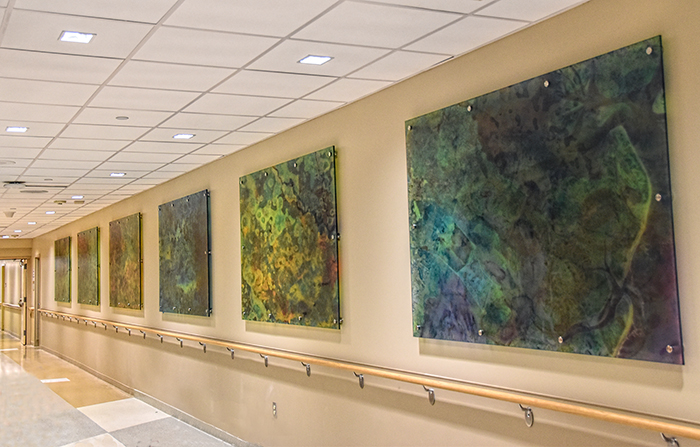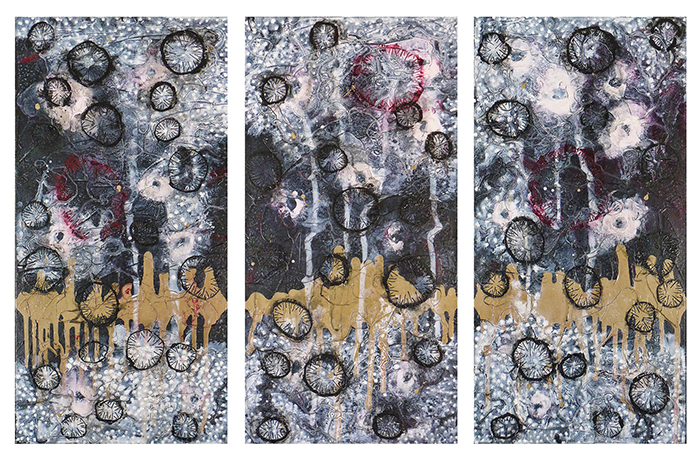
Joanie Gagnon San Chirico is an environmental artist who exhibits her work and creates numerous commissions for public spaces. She is also a Signature Artist Member of the Noyes Museum of Art, Oceanville, NJ and represented by several galleries. She has had 17 solo exhibits and has exhibited her art around the world, including projects with the Brooklyn Museum of Art, Noyes Museum of Art and the Columbus Museum of Art.
She recently completed a large project for the main registration lobby of the newly updated AtlantiCare Regional Medical Center in Pomona, NJ. AtlantiCare has previously commissioned her to create work for three additional locations.
I’ve had the honor and pleasure of knowing Joanie and her extraordinary artwork for several years. She served as a co-juror with me for the Manhattan Arts International Healing Power of ART exhibition in 2010.
RP: Joanie, please briefly describe your art.
JGSC: My work relates to preservation regardless of the series. I portray imagery of the planet’s fragile beauty while questioning our culture, which promotes instant gratification while ignoring evolving consequences.
RP: What motivates you as an artist?
JGSC: I feel obligated to make work that addresses these issues. By working this way, I stay true to my convictions, and can possibly raise awareness after viewers realize that these are not just pretty paintings, the beauty is only skin deep; a reminder that it’s urgent to understand what is real and what is fabricated.
RP: Tell us about your most recent important installation.
JGSC: “Watershed” is a Feature Wall Commission comprised of ten 4×6 foot painting/ecoresin semi-transparent panels for a 100 foot feature wall in the newly redone AtlantiCare Regional Medical Center in Pomona, NJ. It was installed in May 2015. The grand opening was June 4.
The painting panels are layered with satellite maps of the community served by the hospital and embedded between two layers of ecoresin, which is recycled from water and other bottles. With this bird’s eye view, patients and visitors can examine the art to find the location of where they live or work. The panels also depict the relationship and close proximity of local priceless wetlands, including the Edwin B. Forsythe National Wildlife Refuge.
I’m so pleased with the results that I would love to work in resin again soon.

RP: What inspired your algae series?
JGSC: I began my current series depicting harmful algae blooms because of the ongoing issues facing Barnegat Bay close to my home. The work displays my interpretation of existing toxic algae species. My “ghost houses” combine stylized paintings of marks seen on houses post-Sandy layered with my photographs of homes that were marked as tear-downs.
Post Sandy, after the water receded, houses that had been damaged became infested with mold further complicating re-building. These paintings are my interpretation of the mold inundating affected homes.
RP: How do you go about creating your commissioned work and site-specific art?
JGSC: My atrium sculptures and commissioned wall mounted pieces are site-specific and inspired by the environment and the area surrounding the installation.
I work closely with architects, designers and developers. Natural, recycled and organic materials are available for LEED certified buildings and work is available for Evidence-based design (EBD) applications in healthcare. (See editor’s note below about EBD.)
RP: Joanie, what exhibitions do you have planned for the future?
JGSC: “Rock, Paper, Chisel”, at Ocean County Library Main Branch, Toms River, NJ. I am the Co-Curator. The dates are July – September 2015. The next one is “Signature Artist Exhibit”, at Noyes Museum of Art, Oceanville, NJ, which will take place October 2 – November 22, 2015.
Visit Joanie San Chircio’s website www.joaniesanchirico.com
(Editor’s note: Evidence-based design (EBD) is is a field of study emphasizing credible evidence to influence design. This approach has become popular in healthcare to improve patient and staff well-being, patient healing, stress reduction and safety. EBD is a relatively new field, borrowing terminology and ideas from disciplines such as environmental psychology, architecture, neuroscience and behavioral economics. Source: Wikipedia.)
PLEASE SHARE

Leave a Reply